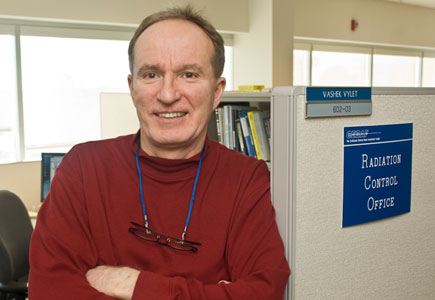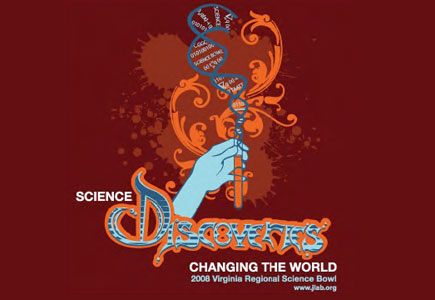
|
January 2008
|
|
|
Thomas Jefferson National Accelerator Facility - A DEPARTMENT OF ENERGY FACILITY
|
|
Congressman Rob Wittman Visits JLab |
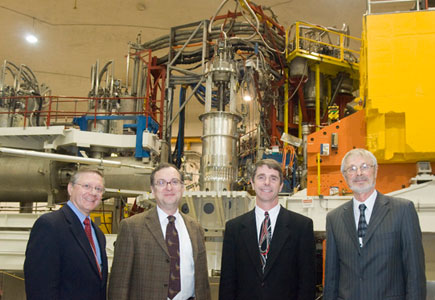 Congressman Rob Wittman, representing Virginia’s 1st Congressional District, visited Jefferson Lab on Jan. 3. He toured the Lab and spoke with Lab managers. He stopped for a photo in Hall C with (from left) JLab DOE Site Office Manager Jim Turi, Physics Division Associate Director Larry Cardman and (far right) Lab Director Christoph Leemann.
Congressman Rob Wittman, representing Virginia's 1st Congressional District, visited Jefferson Lab on Jan. 3 to gain a better understanding of JLab's research program and its economic impact on Virginia. He took the opportunity to tour the accelerator control room (Machine Control Center) one of the Lab's cavernous end stations (Hall C) where physics experiments are run, the Free-Electron Laser and Dilon Technologies, a medical imaging company that licenses JLab-developed detector technology and is based in the Applied Research Center. Wittman learned about JLab's advances in its scientific mission, the study of the building blocks of the nucleus of the atom and received information about the planned upgrade of the Lab's research capabilities and its impact on the future of U.S. science. He heard about the Lab's medical imaging developments and applied-science experiments underway in the Free-Electron Laser facility and met with senior Lab leaders and Department of Energy managers....... more |
|
|
Digital Self-Excited Loop Makes Accelerator Tuning a Breeze
|
In Their Own Words With Radiological Control Manager Vashek Vylet
|
Science Bowl 2008: JLab Volunteers Needed to Help With Tournaments
|
||
|
|
||||
Below the Fold: |
||||
Congressman Rob Wittman Visits JLab |
|
He took the opportunity to tour the accelerator control room (Machine Control Center) one of the Lab's cavernous end stations (Hall C) where physics experiments are run, the Free-Electron Laser and Dilon Technologies, a medical imaging company that licenses JLab-developed detector technology and is based in the Applied Research Center. Wittman learned about JLab's advances in its scientific mission, the study of the building blocks of the nucleus of the atom and received information about the planned upgrade of the Lab's research capabilities and its impact on the future of U.S. science. He heard about the Lab's medical imaging developments and applied-science experiments underway in the Free-Electron Laser facility and met with senior Lab leaders and Department of Energy managers. Wittman was very impressed with the depth and breadth of JLab's basic science and technology transfer programs. He spoke at length with senior management and pledged his support of Jefferson Lab in Washington, D.C. "I am very glad that Congressman Wittman could visit Jefferson Lab and see our programs and facilities firsthand," Lab Director Christoph Leemann said. "We were fortunate to have him visit us so early in his term." The congressman was elected, during a special election held Dec. 11, to serve the unexpired term of the late U.S. Rep. Jo Ann Davis. The 1st District stretches from Fauquier County to Hampton and includes portions of Newport News. Leading up to the December election, Wittman had represented the 99th Legislative District in the Virginia House of Delegates. He holds a Ph.D. in public policy and administration from Virginia Commonwealth University, a master's in health policy and administration from the University of North Carolina, and a bachelor's in biology from Virginia Polytechnic Institute. |
In Their Own Words With Rad Con Manager Vashek Vylet |
|
After my graduation, I briefly worked in a uranium mine as a health physicist. It was a grim and very politicized environment, with armed guards everywhere. The call for one-year of mandatory military service came to me as a relief. After military service, I was fortunate that a position opened up at my alma mater as a teaching assistant/lecturer and I stayed there while I enrolled in the Ph.D. program. Just about the time I was ready to begin my thesis, I was told I would need the authorization of the Communist Party in order to proceed. I was told that I must prove my allegiance and become a member. That was the turning point for me: It was time to leave the country. My two brothers and I were able to get visas as tourists to go to Yugoslavia. From there, in the dark of the night we swam across a bay to Italy, where a friend was waiting for us with dry clothes and papers that would get us to Switzerland. There, I secured a position as a research fellow at the Swiss Federal Institute of Technology in Lausanne, where I was able to pursue my Ph.D. work. My task was to develop a system to measure neutron spectra in Swiss nuclear power plants. I applied for political asylum there, but the Swiss were hesitant. Several years later, my brother and I applied to the United States and we were accepted. That all happened just as I was about to finish my thesis; I got word that I would leave in a month. I had very little sleep during that time; it was crazy, but I managed to finish. After I arrived in the U.S., I was lucky enough to find a postdoc position in the Physics Department at Washington University in St. Louis, Mo., where I stayed for two years working in the cosmic ray group. A position with Fermilab’s radiation protection and health physics program came available and that’s where I started my work around accelerators. From there, I went to SLAC, where I worked in the radiation group for seven years. I gained a lot of knowledge there. By the end of the 1990s, I’d gotten married (my wife, Xuan, is also in health physics) but I’d made the mistake of not buying a home in California when prices were affordable. We knew we wanted to have a family, and that we’d have to move in order to afford a home of our own. I was hired as the associate director of the Radiation Safety Division at Duke University and Duke Medical Center. I also taught in the Physics Department and in the Graduate Program in Medical Physics. Our son, Kai, was born while we were there. When we were in California, I got into sailing and had a 27-foot boat. I missed sailing, and there wasn’t any water near Durham. When I heard about the opening at Jefferson Lab, I saw it as an opportunity to do interesting work on very complex projects and also to be closer to the coast, so I could return to sailing. When we moved here, one of our biggest considerations was to find good schools for Kai, so we chose York County. Xuan is working in medical dosimetry at Chesapeake Regional Medical Center (formerly called Chesapeake General Hospital). One of my greatest challenges as a father is to come up with a story line for the nightly tale I tell Kai. The continuing cast includes "Scrat" and "Squirrel" and that’s what I contemplate on my way home each evening. He’s a tough critic! In addition to my work here, I am co-director of the School of Radiation Protection & Damage at the Ettore Majorana Center in Erice, Sicily, and associate editor of the Health Physics journal, both of which keep me in touch with scientists around the world. as told to Judi Tull |
Science Bowl 2008: JLab Volunteers Needed to Help With High School and Middle School Tournaments |
|
Volunteer support is critical to the success of the Virginia Regional High School Science Bowl on Saturday, Feb. 2, and the Virginia Middle School Science Bowl set for Saturday, March 1. "We need volunteers for a range of activities," she adds. "These events are great fun. And we will provide all volunteers with training, a Science Bowl T-shirt, and lunch if you are working during lunch time. We need you, your co-workers, spouses and children (over age 13) to assist with the many activities required to conduct these academic competitions. "If you have enjoyed being part of the volunteer team for prior Science Bowls, or if you've never been to a Science Bowl, but want to be part of the excitement, we want you," she continues. More than 70 volunteers will be needed to run each of the Science Bowl events. Most of the volunteers needed to support the tournaments will perform as competition moderators, rules judges, timekeepers and scorekeepers during the morning, round-robin sessions, according to Tyler. She will also need a smaller number of volunteers to run the afternoon double-elimination matches, be the on-site scientific judge who is called when a student challenges a question or answer during the competition, and a few individuals to help with administrative tasks. Volunteers may sign up for the morning shift (9 a.m. to 1 p.m.) or the day (9 a.m. to 3 p.m.). High School Science Bowl Volunteers Tournament Training and Practice Sessions Training Session Practice Session This is strictly a volunteer activity, Tyler reminds aspiring helpers. Anyone interested in more information or in volunteering, may contact Tyler by email (tyler@jlab.org) or ext. 7164. Most of the public areas and conference rooms of CEBAF Center will be taken over during each of the competition days. Mornings will consist of round-robin matches, followed in the afternoons by double-elimination rounds. Twenty teams – more than 200 high school students, their families and coaches – that will gather for the high school bowl. Twenty teams have also registered for the middle school tournament. The top three teams of each event earn cash prizes for their respective schools. The top high school team will also win an expenses-paid trip to the Science Bowl Nationals held near Washington, D.C., May 1-6. The top middle school team will advance to middle school nationals, June 19-22 in Golden, Colo. Each team is made up of five students, and a teacher who serves as advisor and coach. A Science Bowl is an academic competition among teams of students who compete in a verbal forum to solve technical problems and answer questions in all branches of science and math. The regional and national events encourage student involvement and interest in math and science activities, improve awareness of career options in science and technology, and provide an avenue of enrichment and reward for academic science achievement. |
Below the Fold |
Advisory Committee Sets Direction for JLab's Scientific ProgramOne by one, the dozen scientists filtered back into a conference room at Jefferson Lab, where sheets of paper, coffee cups, blinking laptop computers and thick, three-ringed binders lay scattered across four tables arranged in a square. To one side of the tables stood Michael Pennington, a nuclear physicist from the University of Durham in England. A member of what is known as the Program Advisory Committee 32, or PAC 32, Pennington waited patiently as the other scientists took their seats so he could announce the future experiments that he and fellow committee members had selected to run at Jefferson Lab. "I think the Lab is to be complimented for providing interesting physics," Pennington said as he began his presentation. "One of the nice things about this PAC is that ...we were able to concentrate on the science." The experiments his committee selected were significant not only for the knowledge they will contribute to the understanding of nuclear physics, but also because they will likely be among the first to run at Jefferson Lab after it upgrades its facilities and doubles the energy of its electron beam accelerator to 12 GeV, or 12 billion electron volts. PAC 33 convenes during January The members of Program Advisory Committee 33, chaired by Roy Holt, Argonne National Lab, will meet at JLab Jan. 14-18, to consider 26 new proposals and one letter-of-intent for experiments using presently available CEBAF beams. This will be the last PAC to consider new proposals for running in the "6 GeV era." Twice a year, Jefferson Lab solicits research experiment proposals. The submissions are scrutinized by the Lab’s program advisory committee, which acts as a scientific "jury" and ranks and prioritizes the proposed experiments. The committee is an independent group composed of internationally respected scientists with different areas of expertise. The committee strives to select the very best and most cutting-edge science to run at JLab. Similar review committees exist at other research laboratories in the United States and around the world. During the review process held at Jefferson Lab Aug. 6-8, 2007, members of the committee listened to presentations and reviewed proposals. Coming from France, Italy, Germany, Poland, England and the United States, the committee members brought a diversity of perspectives to the table. They discussed, debated and, finally, winnowed the proposals based on scientific merit and feasibility of success. "They’re all central to the 12 GeV Upgrade program," Pennington said of the experiments selected, "in that they study, essentially, the electromagnetic properties of protons, how the features of the proton reflect the properties of their constituents, their flavor, their spin and all the other properties." Typically, it can take weeks or years to develop and write an experiment proposal, which often are based on ideas that have been around for years but not previously studied, says Ron Gilman, chairman of Jefferson Lab’s Users Group and a physics professor at Rutgers University. The Users Group consists of more than 1,200 scientists, primarily university faculty members, who use the facilities at Jefferson Lab to conduct experiments. Gilman says that submitting a research proposal to a PAC is like submitting an article to a scientific journal. The comments provided by members of the PAC can help those who have submitted proposals to refine their experiments and produce better science. Typically, the proposals are submitted by international collaborations of scientists and other experts. Often a scientist from Jefferson Lab is among the collaborators, because of his or her familiarity with the Lab’s capabilities and equipment. "When a proposal is submitted to PAC," Gilman explains, "the committee members can say it’s a great experiment and they approve it. Or they may say it’s a good experiment but we don’t have any beam time to give you; in that case you’re usually deferred with regret. Or they may decide that this proposal wasn't as interesting as some others, so you’re not approved, but you are welcome to return in the future and make your proposal more compelling." As an advisory group, the committee submits its selections to Jefferson Lab’s director, who makes the final decision. Invariably, the director accepts the PAC’s decisions and the experiments are scheduled. At Jefferson Lab, about 25 to 30 experiment proposals are submitted each year. The PAC 32 reviewed nine proposals and three letters of intent, with five of the proposals approved and three conditionally approved. These experiments will run after the 12 GeV Upgrade is complete. PAC approval begins a lengthy process for those that were selected. For researchers, the wait to start an experiment is routine. At Jefferson Lab, the demand for beam time is extremely competitive because it is the world’s leading facility in the experimental study of hadronic matter. The Lab’s typical backlog of approved experiments is about four years, which is considered efficient for scheduling purposes. The Lab will not allow the backlog to become too long, because it can threaten funding for researchers, particularly for college students and professors. Of course, for this particular PAC, which focused on experiments to run after the 12 GeV Upgrade is complete, the wait is likely to be seven to 10 years. The funding at Jefferson Lab comes primarily from the U.S. Department of Energy’s Office of Science which provides the funds for operating the accelerator and the support for setting up and running experiments including funds to fabricate experimental instrumentation. In conjunction with DOE, the National Science Foundation and other countries provide funds to support university research groups for running experiments at JLab and related experimental equipment. Once scheduled, installed and calibrated, a typical experiment at Jefferson Lab will run anywhere from a few weeks to several months, depending on the type and frequency of the interactions being studied. Following the completion of the experiments, it will take months or even years to interpret the data and publish the results in a journal. Particle Physics Goes Nuclear: Detector Tests for MINERvA ExperimentLast summer, scientists tested a set of prototype detectors in Hall C that were built for the MINERvA experiment at Fermilab. MINERvA will measure how neutrinos interact with matter and study the structure of the nucleus and its building blocks, protons and neutrons. Every second, 100 billion neutrinos from the sun pass through your thumbnail. Despite the ubiquitousness of these tiny particles, very little is known about them. An experiment set to start at Fermilab in 2009 aims to change that. Last summer, scientists tested a set of prototype detectors in JLab’s Hall C that were built for the Fermilab experiment. Of Matter Dark and Light Neutrinos are born of the process that lights up stars. Oddly enough, neutrinos may also account for some of the missing matter in the universe: so-called dark matter. Neutrinos are born of the process that lights up stars. Deep in the sun, protons in the sun's vast store of hydrogen atoms are squished together to make helium. Each time this happens, two neutrinos pop out and cruise through the sun and into the wide universe. In fact, about 100 billion neutrinos from the sun stream through each square centimeter on Earth every second. Neutrinos are all around us, but they're very difficult to study. The average neutrino will pass through matter with no hesitation. Very rarely, however, a neutrino may pass close enough to the nucleus of an atom to interact with it, creating a signature that physicists can study. These signatures are so rare that there aren't enough to put together a good description of how neutrinos from the sun interact with matter. So rather than rely on the sun, scientists working on the Main Injector Neutrino ExpeRiment v-A, or MINERvA, will study how machine-made neutrinos interact with the nucleus of the atom. 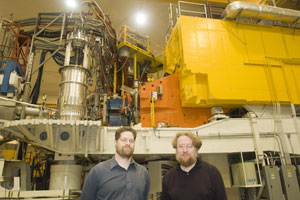 M. Eric Christy, a JLab User and Hampton University professor (left), pauses in Hall C with Hall Leader Stephen Wood. The Hall C Short Orbit Spectrometer was used to test the prototype of a detector that will be used for an experiment to run at Fermilab.
M. Eric Christy, a JLab User and Hampton University professor, is working on the project. He says the experiments at Fermilab will brun similarly to those at Jefferson Lab, where a beam of electrons is hurtled into the nuclei of atoms to study the structure of protons and neutrons. Sophisticated detectors will record information about the particles that emerge from these collisions. Instead of electrons, for the MINERvA experiment, a beam of neutrinos will be directed at various nuclei. By comparing how neutrinos and the better-understood electrons interact with the nucleus, physicists may garner new information about the mysterious neutrino and perhaps even more insights into the nucleus, as well. "My interest is mainly in trying to understand these same quantities that we do here with a different interaction," Christy says. Christy and his colleagues recently built and tested a prototype of one of the types of detectors, a scintillator array, that will be installed in MINERvA. The test run at JLab was actually the result of a bit of serendipity. It turned out that the Short Orbit Spectrometer wasn't needed in the last experiment run in Hall C before the accelerator maintenance period. Christy, who was working on one of the Hall C experiments at the time, jumped at the rare chance to take data for two completely separate experiments at once. He and his colleagues outfitted the SOS with prototypes of the MINERvA detectors. "We had this nice spectrometer with a set of tracking and trigger detectors and electronics already set up. So all we needed to do is stick the detectors in the spectrometer. This gave us data with fairly low effort that we could get almost immediately," he explains. 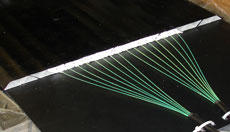 Fiber-optic cables extend from the triangular plastic scintillators. The overlapping triangular scintillator design allows scientists to get better information on the position of charged particles that stream through the detector plane and to better measure the particles’ energies.
The full-size MINERvA scintillator assemblies will consist of 196 planes of scintillator material, each plane measuring about two meters on the side and about 4 centimeters thick. A plane will contain 127 triangular strips of plastic scintillator material. At the center of each triangular strip is a fiber-optic cable. During the experiment, as a particle strikes a scintillator, it will produce light inside the scintillator material. The light is collected by the fiber-optic cable and is sent into a photomultiplier tube, which converts the light into an electronic signal. The prototype detectors used in the recent test at JLab consisted of three planes, each outfitted with 27 triangular scintillator strips. Of those, 12 scintillators in the center of the block were connected to a photomultiplier tube. The prototype was built by Hampton University and The College of William & Mary. Christy and his colleague Jeff Nelson at W&M led the effort. These detectors were installed in Hall C's Short Orbit Spectrometer, which was moved so that it would only be exposed to particles that were knocked out of the target backwards to the incoming electron beam. Particles coming out of the target at these angles are mostly pions, which are one of the types of particles that Christy and his colleagues expect to get from the neutrino-nucleus collisions in MINERvA. "About all you get off the target at these backward angles are pions; and that's fine, because we were interested in the response of our detector to pions." He adds. The test had two goals: To measure how well the detector tracks particles expected from the neutrino-nucleus collisions and to provide data for testing the procedures that will later be used to interpret data from MINERvA's complicated detector design, the overlapping triangle scintillators. "We got tens of millions of events in 10 days of running at the end, when we really got to focus on this experiment. As we analyze the data from these tests, we'll learn a lot about the efficiency of the detectors," Christy comments. "It really gives us a jump start on learning how to analyze data for the later test runs." Christy says graduate students are currently analyzing the data collected in the run. The next detector test is planned for a full-scale set of MINERvA detectors at Fermilab next winter. In the meantime, he's looking forward to the data he's expecting from MINERvA. "It's complementary to the sort of things that we're doing here," he says. He hopes to use the data from the MINERvA experiment to study the structure of protons and neutrons. In particular, it may be possible to determine the contributions of the permanent resident "valence" quarks in the proton from the "sea" quarks – those that visit from time to time. For more information about neutrino physics at JLab, visit: /sites/default/files/April2005.pdf SURA Deeds Land for Major Jefferson Lab UpgradeLand needed for the $310 million upgrade of Jefferson Lab was deeded to the U.S. Department of Energy on Oct. 5. 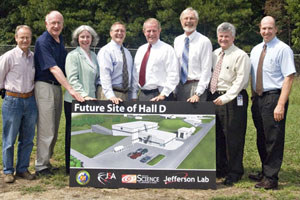 Key Jefferson Lab, SURA and Department of Energy Site Office leaders visited the site where Hall D will be constructed – to mark the land transfer for the new experimental hall – from SURA to the DOE. Event participants included (l. to r.) Elton Smith, Hall D staff scientist; Roy Holt, chair of JLab’s Program Advisory Committee; Allison Lung, 12 GeV deputy project manager; Jim Turi, manager of JLab’s DOE Site Office; Jerry P. Draayer, SURA president & CEO; Christoph Leemann, JLab director; Anthony Thomas, JLab chief scientist; and Joe May, DOE Accelerator Operations & Projects program manager at JLab.
Jefferson Lab, one of the national research facilities funded by DOE's Office of Science, plans to double the energy of its electron beam accelerator (from 6 GeV to 12 GeV), enhance the capabilities in the three existing experimental halls (Hall A, Hall B, Hall C), and construct a new experimental hall (Hall D). But before going forward with the upgrade, the DOE first needed to acquire 7 acres adjacent to its existing 162-acre parcel. DOE took ownership of the additional land from the Southeastern Universities Research Association. SURA is the majority owner of Jefferson Science Associates, LLC, the management and operating contractor of Jefferson Lab for DOE. "When the City of Newport News deeded to SURA a 44-acre plot at the beginning of construction of the research laboratory in the 1980s, few would have imagined the growth of this world-class facility and the world-class science it has accomplished," said Jerry P. Draayer, SURA President & CEO. "SURA is honored to return a portion of that land now for the construction of Hall D, from which we’ll see an even greater return on our investment in science and education." The city’s contribution also included the primary support for SURA to construct the Residence Facility, which has been used over the past decade to house thousands of researchers who have conducted experiments at Jefferson Lab. SURA was originally awarded the contract to design the laboratory in 1983 and operated the Lab following its completion until Jefferson Science Associates was awarded the management and operations contract in April 2006. (Information courtesy of SURA news release.) JLab Science, Math Outreach Program Needs Your HelpBEAMS – Becoming Enthusiastic About Math and Science – Jefferson Lab's long-running math and science enrichment program needs volunteers to assist with classroom-setting, student activities conducted at the Lab during normal business hours. BEAMS supports Newport News inner-city public school students as they progress from sixth through eighth grade. Nearly 1,500 students and their teachers visit JLab between two and five days each school year to participate in science and math activities conducted by JLab scientists, engineers, technicians and administrators. Volunteers spend about 75 minutes in a BEAMS classroom (VARC 72A & 72B), either leading an activity or assisting the students as they carry out an activity. The next round of BEAMS visits begin in February. Usually two classes of students attend at a time and participate in two to four separate activities during each day-long visit. Volunteers lead or assist with the following activities: • Go-Far Cars: Determine how the height of an inclined ramp (potential energy) impacts the distance a model car travels. "JLab staff, students and users are critical to the success of all of the Lab's science education programs, especially BEAMS," says Christine Wheeler, Science Education administrator. "Our BEAMS volunteers have been exposing young students to the applications, importance, and excitement of mathematics and scientific principles for more than 16 years. Students get to learn about you and your job and you get to have fun working with lots of smiling faces. Everybody wins!" "We'd love to have you join us: for the first time, the hundredth time, or for the first time in a long time," she adds. "Want to help, but not sure how? That's what we're here for," Wheeler explains. "Science Education staff will provide the training you need. If you want to observe a classroom activity to learn more, we can schedule that." For additional information, contact Wheeler at ext. 7560 or email wheelerc@jlab.org. The program's goals include: strengthening students' math and science skills with hands-on activities, and having them interact with individuals who use math and/or science in their daily work environment. BEAMS also provides teachers with classroom activities based on JLab science and technology. |
|
The On Target newsletter is published monthly by the Thomas Jefferson National Accelerator Facility (Jefferson Lab), a nuclear physics research laboratory in Newport News, Virginia, operated by Jefferson Science Associates, LLC, for the U.S. Department of Energy's Office of Science. Possible news items and ideas for future stories may be emailed to jlabinfo@jlab.org, or sent to the Jefferson Lab Public Affairs Office, Suite 15, 12000 Jefferson Avenue, Newport News, VA 23606
|


 The digital revolution has transformed everything from photography to television. Now the trend is influencing accelerator technologies and may soon revolutionize accelerator operation.....
The digital revolution has transformed everything from photography to television. Now the trend is influencing accelerator technologies and may soon revolutionize accelerator operation.....  I was born in the country that was formerly Czechoslovakia but as a teen-ager my family moved to Algeria, where I attended a French high school. We returned in 1971; but after the invasion of the Czech Republic it was a very dark and depressing time......
I was born in the country that was formerly Czechoslovakia but as a teen-ager my family moved to Algeria, where I attended a French high school. We returned in 1971; but after the invasion of the Czech Republic it was a very dark and depressing time......  The 2008 National Science Bowl® season is just around the corner, and Jefferson Lab's Science Education team seeks volunteers from across the campus to help with tournaments being held at the Lab in February and March.....
The 2008 National Science Bowl® season is just around the corner, and Jefferson Lab's Science Education team seeks volunteers from across the campus to help with tournaments being held at the Lab in February and March..... 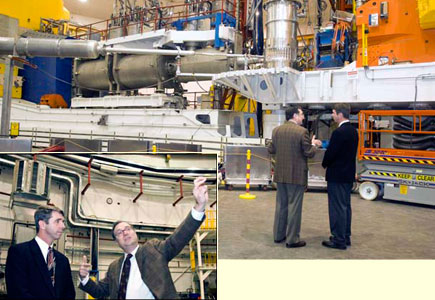
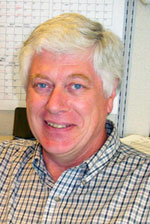 Jean Delayen
Jean Delayen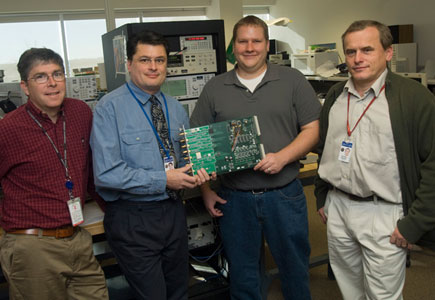 Engineering Division staff engineers (from left) Curt Hovater, John Musson, Trent Allison and Tomasz Plawski are working with Jean Delayen to take Delayen’s cavity-tuning technology digital.
Engineering Division staff engineers (from left) Curt Hovater, John Musson, Trent Allison and Tomasz Plawski are working with Jean Delayen to take Delayen’s cavity-tuning technology digital.